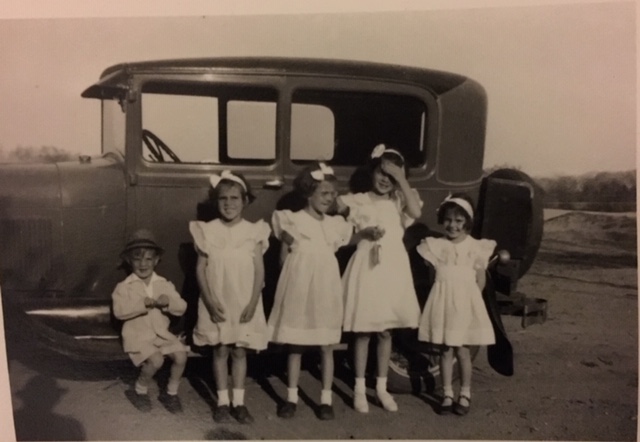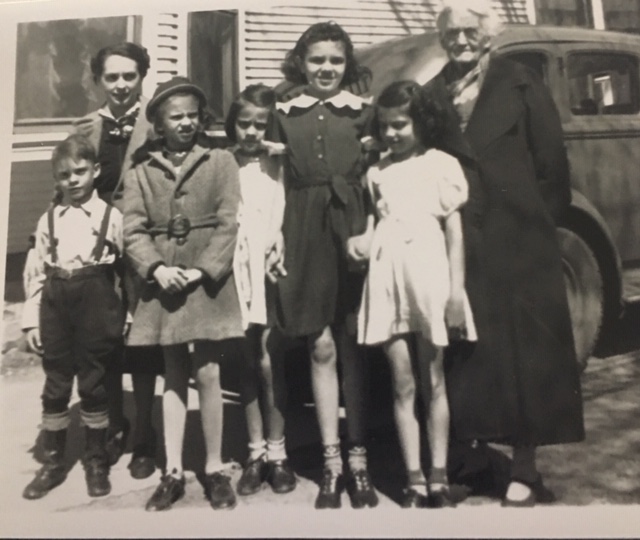
Editor’s note: Reader Rita Hephner came across this story of Depression Era Wichita while going through some family papers. It was written by her mother, Lela Eitel, and presented to Lela’s siblings at Christmas in 2000 – with a white sack full of candy, naturally.
This little story is about a white sack and its significance to five children who lived on South Water Street in Wichita, Kan. John and Lela Bush had moved their family to this address in 1935. The children were Alice Julia, called Julia, who was the oldest; Rose Marie, who was next oldest and the frail one; Lela Mae, the middle child; Edna Carolyn, called Eddie; and John Russel, Jr., who was called Johnny.
They were good little kids – or so their mother told them in later years, after she’d had time to think about it. However, their mother didn’t know everything about her children.
In those days of the Great Depression, few women worked outside the home. The little Bush children felt fortunate to have a full-time mother who cooked and sewed and was always there for them – except on days of the city-wide sales.
The city-wide sale was called “Dollar Day,” and was always held on Wednesday during that time in Wichita. Housewives would rise early that day and exchange their usual attire of a cotton printed housedress and apron for their Sunday dress, silk hose, girdle, a hat (always) and gloves (even in the summertime).
On a typical Wednesday, just before Mama Bush would cross the street to board the South Main bus, she’d give last-minute instructions accompanied by a few warnings to her little brood. “You are not to go out of the yard. You cannot cross the street. You cannot have any other kids over to play while I’m gone. And don’t fight – I better not here of any fighting while I get back.” (She didn’t know about them using the telephone to play pranks on people, such as calling shopkeepers to ask: “Do you have Prince Albert in a can?”)
The Bush kids weren’t dumb; they knew their mother needed some time away from home. And they loved to hear her tell of finding piece goods on sale at Buck’s or Hinkles or Geo. Inne’s “for only 50 cents a yard,” as she’d say, her facing beaming with pride over the bargain.
The children didn’t mean to break the rules, and they didn’t plan to begin a fight. But somehow, sooner or later, it would happen. Sometimes Julia would practice her baton twirling in the front yard if the weather was nice. The little ones sitting on the old porch steps watching would get bonged on the head a few times, and the fight was on, complete with screaming, hollering and chases around the front yard. Julia had a technique of swinging a broom in front of her to and fro to keep the others at a distance.
Some inner instinct always told the kids when it was time to watch for the bus and Mama’s return (as none of them wore or had ever owned a watch at that time).
“I hear the bus coming!” one would say. “Is she on it?” another would ask. And when Mama was spotted came the most important question of all: “Does she have the white sack?”
If the answer was yes, then all fighting stopped immediately and there was no tattling. Like I said, they weren’t dumb kids. They knew the sack contained candy, and that Mama was perfectly capable of withholding it or even administering further punishment if she suspected misbehavior. Usually, however, each child received one chocolate covered crème drop before Mama put the white sack on the highest shelf in the kitchen cupboard.
The Thursday after one particular Dollar Day, when Mama was away from home for a short time, little Johnny asked Lela Mae to get the white sack down for him. “No,” she said. But she couldn’t stand his begging, so she got a chair and managed reach up to the top shelf to retrieve the sack. Johnny and Lela Mae each ate one or two chocolate covered crème drops, positive they wouldn’t be missed.
And indeed, the sack wasn’t checked until sometime during that night, after Johnny began howling with pain. He was having severe cramping in his legs.
Mama soon appeared at Lela Mae’s beside asked if she’d gotten into the candy. “No,” Lela Mae lied. With a stern face and pursed lips, her mother said, “I know better!”
Their punishment turned out to be even more drastic than feared. Neither Lela Mae nor Johnny was allowed dessert for two weeks. Not even during a trip to Grandma Triboulet’s for a fried chicken dinner, which always ended with a mouth-watering lemon meringue pie. No amount of begging could reverse their mother’s decision.
Eventually, they were allowed Dollar Day treats from the white sack again, and all the Bush kids spent many a Wednesday watching for it and their mother to return on the bus. Even decades later, with children and grandchildren of their own, I imagine they feel a bit of excitement and get a little nostalgic at the sight of a white sack. I know I do.
Editor’s note: Hephner says she isn’t sure of the connection in the story between the stolen candy and Johnny’s leg cramps. Guilt? Or the idea that too many sweets were bad for you? Lela died of breast cancer in 2008, having left her family with many stories of her life.










